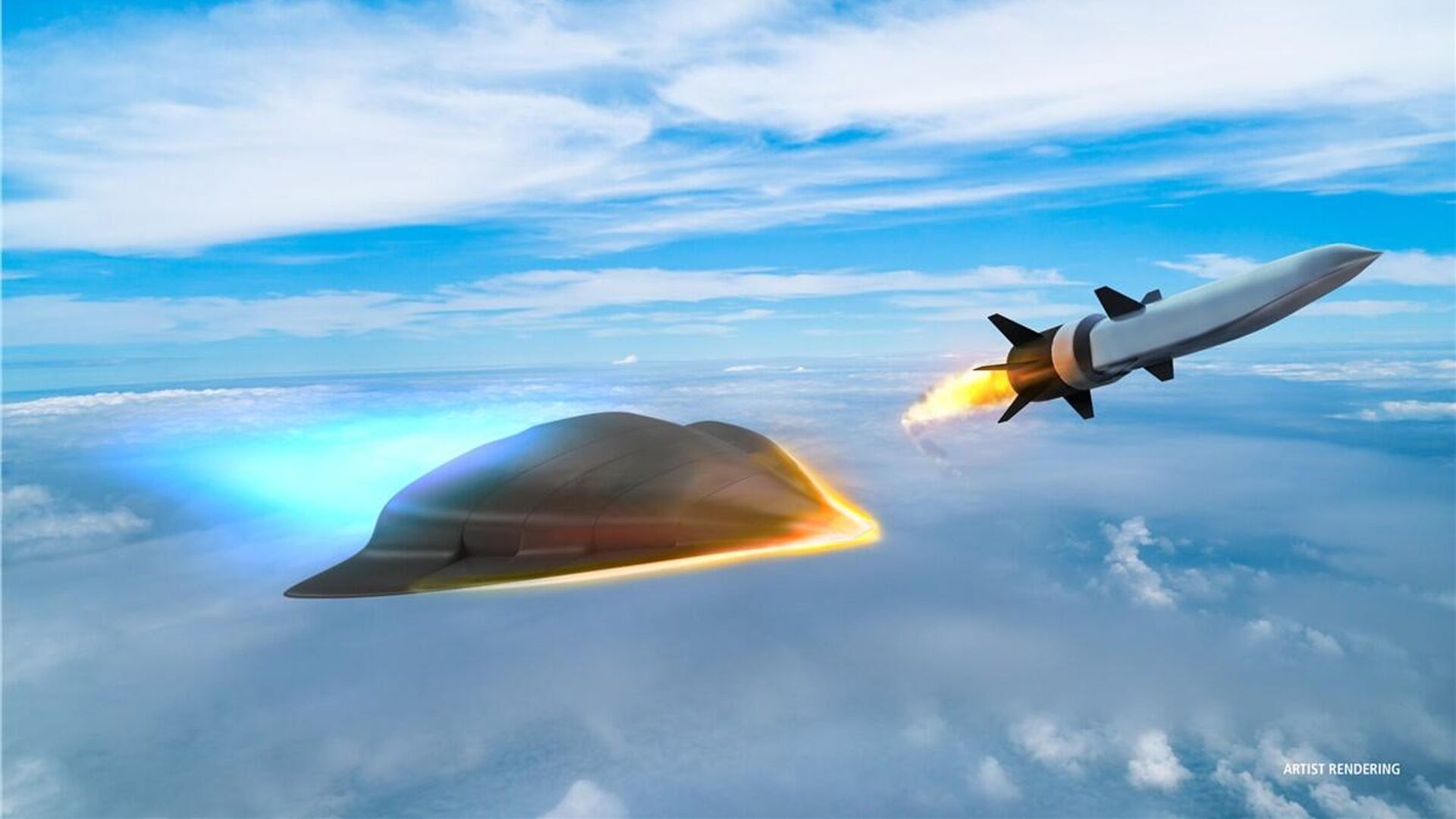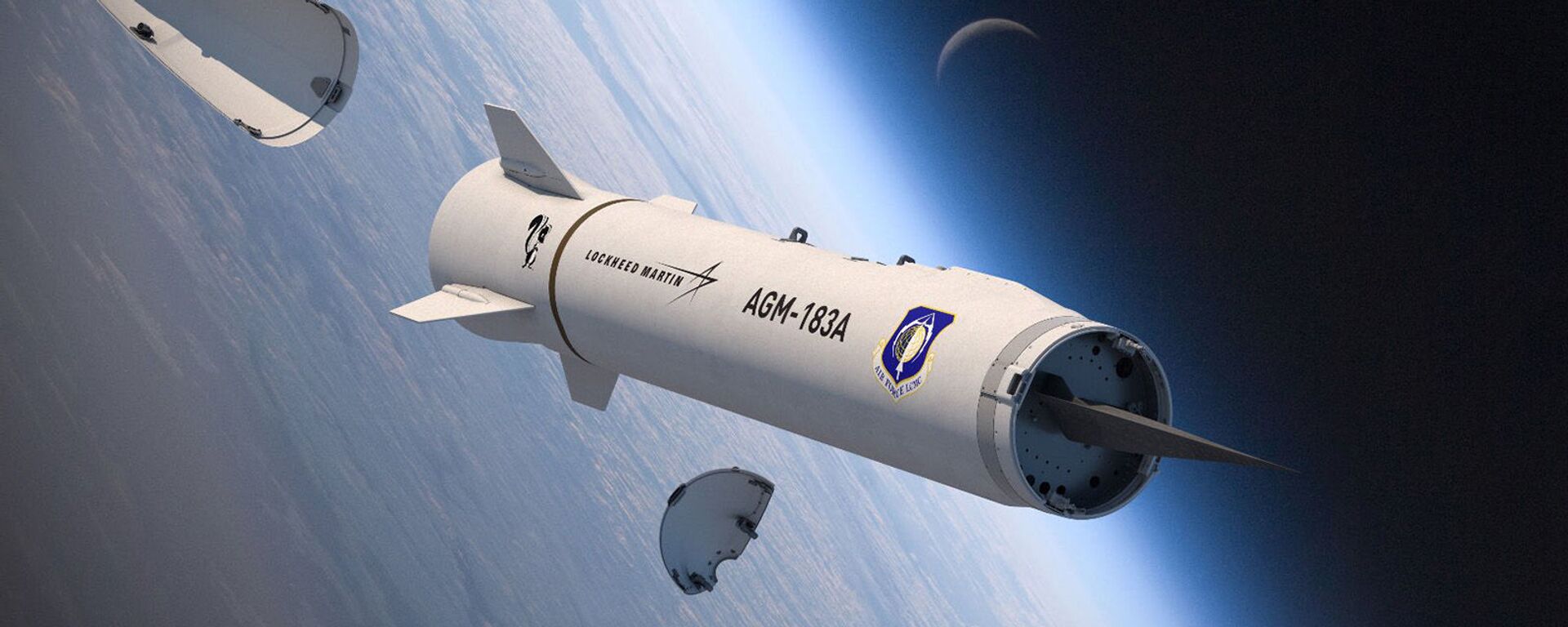https://sputnikglobe.com/20230330/what-is-the-us-plan-for-developing-hypersonic-missiles-1108950165.html
What is the US Plan for Developing Hypersonic Missiles?
What is the US Plan for Developing Hypersonic Missiles?
Sputnik International
US Secretary of the Air Force Frank Kendall acknowledged that the latest test of the hypersonic missile ARRW "was not a success," even though it met some of the objectives.
2023-03-30T11:28+0000
2023-03-30T11:28+0000
2023-04-06T15:22+0000
us
hypersonic missiles
us air force
military
https://cdn1.img.sputnikglobe.com/img/07e6/07/13/1097586461_0:79:1200:754_1920x0_80_0_0_2441462d680d518474bc8086c964bd14.jpg
The US Air Force (USAF) plans to end a hypersonic weapons program under development by Lockheed Martin Corp., Air Force Assistant Secretary for Acquisition Andrew Hunter told the House Armed Services Committee.He declined to elaborate on why the Air Force was giving up on the Lockheed program, but the development comes after Air Force Secretary Frank Kendall admitted that a recent ARRW test “was not a success,” as the service “did not get the data we needed.” With the Lockheed program apparently coming to a standstill, what is expected to be the USAF’s new plan for hypersonic weapons? Sputnik has answers to this and other questions.What is ARRW?The AGM-183 ARRW ("Air-Launched Rapid Response Weapon") is a hypersonic air-to-ground missile, which moves at a maximum speed of more than Mach 5 (over 1,656 meters per second) and has an operational range of about 1,000 miles (1600 km).The weapon uses a boost-glide system, in which it is propelled to hypersonic speed by a rocket on which it is mounted before gliding toward a target.How Much is ARWW?Earlier this year, the US’ Congressional Budget Office estimated that a joint production run of 300 ARRWs (involving Lockheed's participation) would have a cost of $14.9 million per one such missile and a program cost of $5.3 billion including platform integration and 20 years of sustainment.It remains unclear how much the Pentagon injected in ARWW tests before deciding to scrap the program, but it’s safe to assume the tests amounted to a hefty sum given the cost of an ARRW piece.Lockheed Program Ends, What's Next?After the USAF announced it won’t pursue a hypersonic weapons program under development by Lockheed Martin Corp., Air Force Secretary Frank Kendall made it clear the USAF was “more committed” to different initiative, the so-called Hypersonic Attack Cruise Missile (HACM) built by rival Raytheon Corp.He apparently referred to the fact that the Raytheon weapon flies on its own while the ARRW is launched from a rocket before the warhead separates and glides at hypersonic speed to a target.What is the HACM Missile? Raytheon-developed HACM is an air-launched, scramjet-powered hypersonic weapon built in partnership with Northrop Grumman.The missile is the successor of the Hypersonic Air-breathing Weapon Concept (HAWC) and the Southern Cross Integrated Flight Research Experiment (SCIFiRE) hypersonic programs.The $985 million contract to develop the HACM, which is fitted with a Northrop Grumman scramjet, was awarded by the USAF to Raytheon in September 2022."The HACM will provide our commanders with tactical flexibility to employ fighters to hold high-value, time-sensitive targets at risk while maintaining bombers for other strategic targets," he claimed.What About Other US Hypersonic Programs?Apart from the ARRW and the HACM, the US military has been developing the Conventional Prompt Strike (CPS) and the Long Range Hypersonic Weapon (LRHW) programs.The CPS is the Pentagon's upcoming project being jointly developed by the Navy and the Army in cooperation with Lockheed.The Navy plans to begin deploying the capability on stealthy Zumwalt-class destroyers in fiscal 2025 and Virginia-class submarines in fiscal 2028, while the Army will operate a land-based variant.The Dynetics- and Lockheed-developed LRHW is a medium-range surface-to-surface hypersonic weapon, which consists of a large rocket booster that carries the unpowered Common-Hypersonic Glide Body (C-HGB) in a nose cone. Once the booster reaches relevant altitude and speed, it releases the C-HGB, which glides at hypersonic speeds as it descends towards its target.The Army intends to deploy the LRHW in an eight missile battery containing four M983 trucks and trailers each holding two missiles in launch canisters alongside a command vehicle.
https://sputnikglobe.com/20230310/ex-pentagon-officer-us-still-playing-catchup-with-hypersonics-after-underestimating-china-russia-1108276015.html
Sputnik International
feedback@sputniknews.com
+74956456601
MIA „Rossiya Segodnya“
2023
Oleg Burunov
https://cdn1.img.sputnikglobe.com/img/07e4/09/0b/1080424846_0:0:2048:2048_100x100_80_0_0_3d7b461f8a98586fa3fe739930816aea.jpg
Oleg Burunov
https://cdn1.img.sputnikglobe.com/img/07e4/09/0b/1080424846_0:0:2048:2048_100x100_80_0_0_3d7b461f8a98586fa3fe739930816aea.jpg
News
en_EN
Sputnik International
feedback@sputniknews.com
+74956456601
MIA „Rossiya Segodnya“
Sputnik International
feedback@sputniknews.com
+74956456601
MIA „Rossiya Segodnya“
Oleg Burunov
https://cdn1.img.sputnikglobe.com/img/07e4/09/0b/1080424846_0:0:2048:2048_100x100_80_0_0_3d7b461f8a98586fa3fe739930816aea.jpg
usaf's plan to end arrw hypersonic weapons program, latest unsuccessfull test of the us hypersonic missile arrw, raytheon-developed hypersonic attack cruise missile
usaf's plan to end arrw hypersonic weapons program, latest unsuccessfull test of the us hypersonic missile arrw, raytheon-developed hypersonic attack cruise missile
What is the US Plan for Developing Hypersonic Missiles?
11:28 GMT 30.03.2023 (Updated: 15:22 GMT 06.04.2023) US Secretary of the Air Force Frank Kendall acknowledged earlier this week that the latest test of the hypersonic missile ARRW "was not a success," even though it met some of the objectives.
The US Air Force (USAF)
plans to end a hypersonic weapons program under development by Lockheed Martin Corp., Air Force Assistant Secretary for Acquisition Andrew Hunter told the House Armed Services Committee.
According to Hunter, the USAF “currently intend to pursue follow-on procurement” of the hypersonic weapon known as ARRW, though it will conduct two additional flight tests of it to accumulate important data.
He declined to elaborate on why the Air Force was giving up on the Lockheed program, but the development comes after Air Force Secretary Frank Kendall admitted that a recent ARRW test “
was not a success,” as the service “did not get the data we needed.” With the Lockheed program apparently coming to a standstill, what is expected to be the USAF’s new plan for hypersonic weapons?
Sputnik has answers to this and other questions.
The AGM-183 ARRW ("Air-Launched Rapid Response Weapon") is a hypersonic air-to-ground missile, which moves at a maximum speed of more than Mach 5 (over 1,656 meters per second) and has an operational range of about 1,000 miles (1600 km).
The weapon uses a boost-glide system, in which it is propelled to hypersonic speed by a rocket on which it is mounted before gliding toward a target.
Earlier this year, the US’ Congressional Budget Office estimated that a joint production run of 300 ARRWs (involving Lockheed's participation) would have a cost of $14.9 million per one such missile and a program cost of $5.3 billion including platform integration and 20 years of sustainment.
It remains unclear how much the Pentagon injected in ARWW tests before deciding to scrap the program, but it’s safe to assume the tests amounted to a hefty sum given the cost of an ARRW piece.
Lockheed Program Ends, What's Next?
After the USAF announced it won’t pursue a hypersonic weapons program under development by Lockheed Martin Corp., Air Force Secretary Frank Kendall made it clear the USAF was “more committed” to different initiative, the so-called Hypersonic Attack Cruise Missile (HACM) built by rival Raytheon Corp.
Kendall pointed out that “we see a definite role” for the Raytheon missile because “it’s compatible with more of our aircraft and it will give us more combat capability overall.”
He apparently referred to the fact that the Raytheon weapon flies on its own while the ARRW is launched from a rocket before the warhead separates and glides at hypersonic speed to a target.
What is the HACM Missile?
Raytheon-developed HACM is an air-launched, scramjet-powered hypersonic weapon built in partnership with Northrop Grumman.
The missile is the successor of the Hypersonic Air-breathing Weapon Concept (HAWC) and the Southern Cross Integrated Flight Research Experiment (SCIFiRE) hypersonic programs.
The missile is designed to tackle high-value targets in contested environments from standoff distances. Like the ARRW, the HACM’s maximum speed stands at more than Mach 5, while its operational range amounts to about 1,000 miles.
The $985 million contract to develop the HACM, which is fitted with a Northrop Grumman scramjet, was awarded by the USAF to Raytheon in September 2022.
USAF chief of staff, Gen. Charles Q. Brown Jr. described as a “powerful example of developing and integrating combat capabilities alongside our partners from the beginning."
"The HACM will provide our commanders with tactical flexibility to employ fighters to hold high-value, time-sensitive targets at risk while maintaining bombers for other strategic targets," he claimed.
What About Other US Hypersonic Programs?
Apart from the ARRW and the HACM, the US military has been developing the Conventional Prompt Strike (CPS) and the Long Range Hypersonic Weapon (LRHW) programs.
The CPS is the Pentagon's upcoming project being jointly developed by the Navy and the Army in cooperation with Lockheed.
According to the Navy, the CPS weapon system “will deliver a hypersonic conventional offensive strike capability through a depressed boost-glide trajectory to prosecute deep-inland, time-critical, soft and medium-hardened targets in contested environments.”
The Navy plans to begin deploying the capability on stealthy Zumwalt-class destroyers in fiscal 2025 and Virginia-class submarines in fiscal 2028, while the Army will operate a land-based variant.
The Dynetics- and Lockheed-developed LRHW is a medium-range surface-to-surface hypersonic weapon, which consists of a large rocket booster that carries the unpowered Common-Hypersonic Glide Body (C-HGB) in a nose cone. Once the booster reaches relevant altitude and speed, it releases the C-HGB, which glides at hypersonic speeds as it descends towards its target.
The Army intends to deploy the LRHW in an eight missile battery containing four M983 trucks and trailers each holding two missiles in launch canisters alongside a command vehicle.




